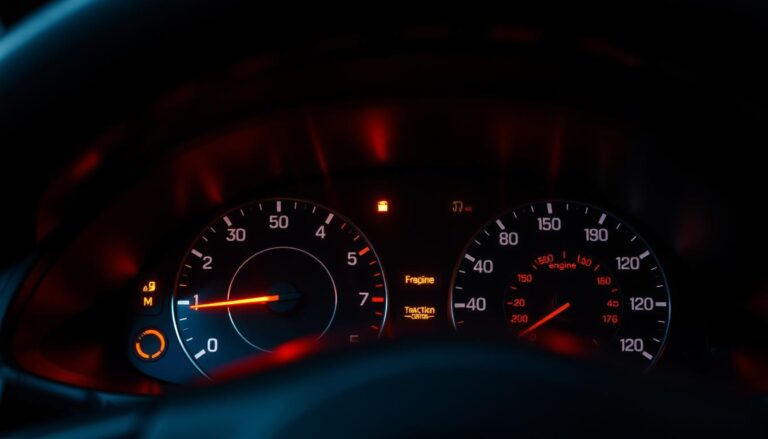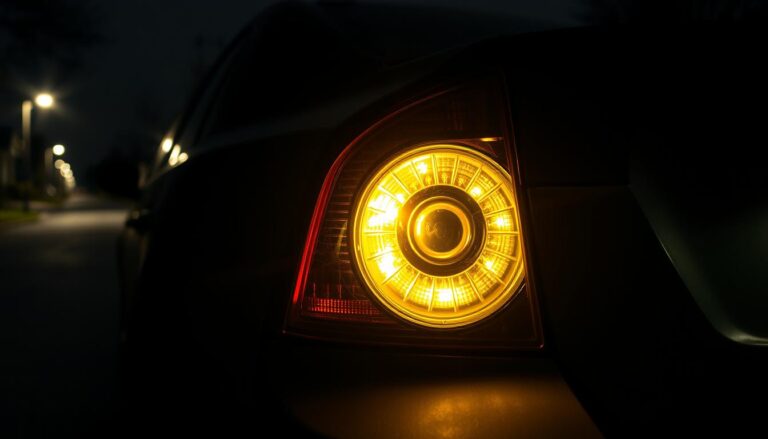This introduction explains what a TPM alert means, why warning lights matter, and how to tell a flashing light from a steady one.
The vehicle uses multiple sensor components to track tire pressure. A flashing indicator that stops after a minute can differ from a steady warning that reads “Tire pressure low.”
Repeated warnings after inflating tires on a Volvo xc60 or other models often point to slow leaks, a failing sensor battery, or the need to reset the tpms after service.
Do not ignore the light. Under-inflation can overheat a tire, reduce fuel efficiency, shorten tread life, and affect handling and braking. Monthly cold checks, including the spare, are still essential.
This guide shows clear steps for quick driveway checks, how to spot compatibility issues after fitting alternate wheels, and when specialized diagnostics are the smarter choice.
Key Takeaways
- Warning lights can be flashing or steady; each signals a different issue.
- Cars rely on dedicated sensors to track tire pressure and show messages.
- Persistent alerts after airing up often mean leaks, dead sensor batteries, or a needed reset.
- Low pressure harms fuel efficiency, handling, braking, and tire life.
- Perform monthly cold pressure checks on all tires, including the spare.
- Some problems need diagnostics or professional repair, especially after wheel changes.
How Volvo’s Tire Pressure Monitoring System Works Today
Today’s systems send real‑time pressure readings from each wheel to the vehicle receiver. Direct setups use valve‑mounted sensors that transmit data when the car moves at about 20 mph (30 km/h) or faster. Indirect systems infer pressure changes from wheel speed differences.
Direct vs. indirect designs
Direct systems report actual tire pressure and temperature per wheel. Indirect designs use ABS sensors to spot relative pressure loss. Both methods belong to the wider pressure monitoring system used in modern vehicles.
What the warning light and messages mean
A steady telltale plus a message like “Tire pressure low” or “Tire needs air now” means at least one tire needs air. A flashing warning light for about one minute, then a solid lamp, signals a system fault and repeats on restart.
Safety, fuel, and wear impacts
Even small pressure loss raises heat, cuts fuel economy, and shortens tread life. Under‑inflation can change handling and stopping distance and make the engine feel heavier due to extra rolling resistance.
| Aspect | Direct TPMS | Indirect TPMS |
|---|---|---|
| Data source | Valve-mounted sensors | Wheel speed sensors |
| Reports | Individual tire pressure & temperature | Relative pressure change |
| When active | Transmits above ~20 mph | Works whenever wheels turn |
| Notes | Sensors must match tpms system; monthly cold checks | Can trigger with temperature swings; verify cold inflation |
Volvo TPM Malfunction: Symptoms, Causes & Fixes
When the dash light blinks for about a minute and then stays lit, it usually marks a monitoring fault. A steady telltale alone most often points to one or more tires that need air.

What drivers see
Common patterns: a tpms light that flashes then turns solid, a warning light that returns soon after airing up, or a light stays on for days despite correct pressures.
Likely causes
Sensor failures, slow punctures, bead or valve leaks, depleted coin‑cell batteries inside a sensor, or wheels that fail to hold air can all trigger warnings.
“A flashing telltale that becomes steady often means the monitoring system lost communication with one or more sensors.”
| Cause | What it could indicate | Quick fix |
|---|---|---|
| Slow puncture | Low tire pressure | Reinflate to placard spec; repair or replace tire |
| Depleted sensor battery | Sensor may stop transmitting | Replace sensor or battery‑equivalent unit |
| Receiver/module fault | Intermittent communication | Diagnostic scan; module repair or reflash |
- Confirm cold tire pressure before assuming a problem after temperature changes.
- Reset or relearn after rotations; replace mismatched wheels to restore the pressure monitoring system.
- Low tire pressure can make the engine feel heavier; check inflation first.
Step‑by‑Step: Diagnose and Resolve TPMS Warnings
Begin with a cold pressure check across all wheels, including the spare, to rule out simple inflation issues before deeper troubleshooting.
Check cold tire pressures on all wheels, including the spare
Use a calibrated gauge and compare readings to the placard on the driver’s door jamb. If a tire is low, inflate to the placard value and recheck air pressure after a few minutes.
Inspect for leaks, damaged wheels, or valve-mounted sensors
Look for bubbles with a soap spray at the tread, bead, and valve stem. Visually confirm valve-mounted sensor condition on the Volvo xc60 or other model.
Reset and relearn procedures after rotation or tire replacement
Perform the vehicle-specific relearn, then drive above ~20 mph for several minutes so the tpms can receive updated readings.
Interpreting light behavior
A steady light usually means low tire pressure. A blinking sequence before the light stays on points to a fault requiring diagnostics.
| Action | What it shows | Next step |
|---|---|---|
| Cold gauge check | Confirms tire pressure | Inflate to placard; recheck |
| Soap spray test | Finds external leaks | Repair or replace tire/wheel |
| Visual sensor check | Damaged or missing sensor | Replace sensor; relearn |
| Drive relearn | Updates pressure monitoring | Confirm light clears; if not, run diagnostics |
Repairs and Professional Service for Volvo TPMS Issues
Book a technician when repeated pressure alerts persist after you’ve confirmed cold inflation. That is the clearest sign to schedule appointment time for professional diagnostics and repairs.

What the shop will test
A qualified technician will scan the monitoring system to pull error codes and view live data. They will read each tpms sensor ID, pressure, temperature, and battery status.
| Test | Why | Outcome |
|---|---|---|
| Diagnostic scan | Finds stored faults | Targeted repairs or part replacement |
| Sensor live check | Confirms ID and battery | Replace or register sensor |
| Tire & valve inspection | Finds leaks or damaged hardware | Repair, service stem, or replace |
Typical service steps
Technicians will inspect the tire, wheel, and valve hardware for leaks and repair punctures properly. They may save a sensor by fitting a valve service kit when the electronics remain healthy.
When a sensor fails, it is replaced with the correct part, registered to the vehicle, and the monitoring system is recalibrated. Shops confirm compatible tires and wheels before reprogramming and road‑learn.
“Good shops isolate wiring, corrosion, or receiver faults so you get a targeted repair rather than unnecessary part swaps.”
For comprehensive Volvo repair, ask for cleared fault memory and documented results. Bring two key fobs and recent tire invoices to speed setup and warranty checks. This ensures the system alerts reliably next time pressure changes.
Conclusion
Consistent care for tires pays off: confirm cold tire pressure regularly, carry a quality gauge, and log readings so seasonal air changes make sense.
Understand the warning the dash light gives. A blinking then steady sequence often points to a system fault, while a steady lamp usually means low tire pressure. Common issues include slow leaks, worn sensors, or receiver communication faults.
For Volvo xc60 owners, monthly checks on all tires — including the spare — are essential. Use compatible wheels, valves, and sensors and perform a brief drive after service so the monitoring system relearns new components.
If the light stays after inflation and reset, schedule professional diagnostics to test the pressure monitoring system and restore safe, efficient driving.
FAQ
How does the tire pressure monitoring system work on modern Volvo vehicles?
Most current models use direct pressure sensors mounted at each wheel that measure absolute tire pressure and temperature, sending data to the vehicle’s receiver. Some older or lower-spec models use an indirect system that monitors wheel speed via ABS sensors to detect relative pressure loss. The system alerts the driver with a dashboard light and sometimes a message when it detects low pressure or a sensor fault.
What does a flashing warning light versus a steady light mean?
A blinking warning light usually signals a system fault or a failed sensor, while a steady light indicates one or more tires are underinflated. If the light flashes briefly when you start the car then stays solid, that often means the system performed a self-check and detected low pressure that needs attention.
Why does the TPMS light stay on after I inflate the tires?
The light can remain on if a sensor didn’t transmit after inflation, the system needs a reset or relearn, or if a slow leak persists. Temperature changes can also temporarily alter pressure and keep the warning lit until the system registers correct pressures or is reset.
Can cold temperatures cause false low pressure warnings?
Yes. Air contracts in colder weather, lowering tire pressure and triggering a low-pressure warning. Check and adjust pressures when the tires are cold, and the warning will usually clear once correct pressure is reached or after the system relearns.
How often do TPMS sensors fail and what causes failure?
Sensor batteries typically last 5–10 years. Failures occur from battery depletion, corrosion, valve damage, impact from potholes, or seal degradation. Faulty sensors are a common cause of recurring warnings even when tire pressures are correct.
Should I check the spare tire and replace sensors during a tire change?
Check the spare’s pressure and condition. Some vehicles use a full-size spare with a sensor; others do not. When changing tires, inspect valve stems and consider replacing sensors if they’re old or if the tire shop recommends it to avoid future warnings.
What are the basic steps to diagnose a TPMS warning myself?
Park on level ground and measure cold pressure on all four tires and the spare. Look for visible punctures, nails, or rim damage. Inflate to the recommended PSI, then drive to allow the system to update. If the light stays on, try the vehicle’s TPMS reset/relearn procedure listed in the owner’s manual.
When should I take the car to a technician for TPMS issues?
Schedule service if you cannot find a leak, if the warning light blinks (indicating a fault), if a sensor replacement or relearn is required after tire work, or if you suspect receiver/module problems. A trained technician will scan the system, test sensors, and replace or program parts as needed.
Does low tire pressure affect fuel efficiency and tire wear?
Yes. Underinflated tires increase rolling resistance, lowering fuel economy and causing uneven tread wear. Maintaining proper pressure improves mileage, extends tire life, and supports safe handling and braking performance.
Will a check-engine light relate to the tire pressure monitoring system?
Typically the check-engine light is separate from the pressure-monitoring system. However, some vehicle messages can appear together if multiple systems detect faults. Have a technician scan both the TPMS and engine modules to diagnose overlapping warning lights.
How much does it cost to replace a tire pressure sensor?
Costs vary by model, sensor type, and labor rates. Expect parts plus mounting and programming charges. Ask your service center for an itemized estimate; replacing sensors in pairs or all four can be more cost-effective if several are near end of life.
Can I drive with the TPMS warning light on?
If the light indicates low pressure, driving risks reduced handling and tire damage—inflate the tires promptly and avoid high speeds until corrected. If the light signals a system fault, driving is usually possible but you’ll lack accurate pressure monitoring. Get repairs soon to restore safety features.
What happens after tire rotation or replacement—do sensors need reprogramming?
Many systems require a relearn or reset when tires are rotated, replaced, or sensors are swapped. Some vehicles automatically relearn while driving; others need a manual procedure or scan tool to register each sensor’s ID and location to the vehicle’s receiver.



